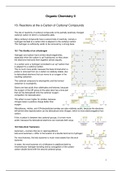Organic Chemistry II
18. Reactions at the α-Carbon of Carbonyl Compounds
The site of reactivity of carbonyl compounds is the partially positively charged
carbonyl carbon to which a nucleophile adds.
Many carbonyl compounds have a second site of reactivity, namely a
hydrogen bonded to a carbon that is adjacent to the carbonyl carbon.
This hydrogen is sufficiently acidic to be removed by a strong base.
18.1 The Acidity of an α-Hydrogen
Hydrogen and carbon have similar electronegativities,
especially when the carbon is sp3 hydrolyzed, so they share
the electrons that bond them together almost equally.
In a carbon acid, a hydrogen is bonded to an sp3 carbon that
is adjacent to a carbonyl carbon.
This is much more acidic, because the base formed when a
proton is removed from an α-carbon is relatively stable, due
to delocalized electrons that can move to an oxygen in the
resulting carbanion.
The carbonyl compound is electrophilic and the formed
carbanion is nucleophilic.
Esters are less acidic than aldehydes and ketones, because
the oxygen of the OR group of the ester also has a lone pair
that can be delocalized onto the carbonyl oxygen;
competition for delocalization.
This effect is even higher for amides, because
nitrogen bears a positive charge better than
oxygen.
Nitroalkanes, nitriles, and N,N-disubstituted amides are also relatively acidic, because the electrons
left behind after deprotonation can be delocalized onto nitrogen, which is more electronegative than
carbon.
If the α-carbon is between two carbonyl groups, it is even more
acidic, because the delocalized electrons can resonate both ways.
18.2 Keto-Enol Tautomers
tautomers = isomers that are in rapid equilibrium
keto-enol tautomers = differ in the location of a double bond and a hydrogen
For most ketones, the keto tautomer is much more stable than the enol
tautomer.
In water, the enol tautomer of a β-diketone is stabilized both by
intramolecular hydrogen bonding and by conjugation of the carbon-
carbon double bond with the second carbonyl group.
1
,The enol tautomer of phenol is more stable than the keto tautomer, because it is
aromatic.
18.3 Keto-Enol Interconversion
Keto and enol tautomers interconvert (also called tautomerization), which can be catalyzed by either a
base or an acid (both little needed).
Mechanism for base-catalyzed keto-enol interconversion
Hydroxide ion deprotonates the α-carbon to form an enolate ion, which has two resonance
contributors; protonation of the oxygen forms the enol tautomer.
Mechanism for acid-catalyzed keto-enol interconversion
The acid protonates the carbonyl oxygen, which increases the acidity of the α-proton, because
deprotonation removes the positive charge on the oxygen.
Water deprotonates the α-carbon to form the enol tautomer.
18.4 Halogenation of the α-Carbon of Aldehydes and Ketones
Halogens can replace one or more of the α-carbons of an aldehyde or a ketone, which is an
α-substitution reaction because one electrophile (e.q. Br +) is substituted for another (H+) on the
α-carbon.
In the acid-catalyzed reaction, the halogen replaces one of the α-hydrogens.
Mechanism for acid-catalyzed halogenation
The carbonyl oxygen is protonated, after which water deprotonates the α-carbon, forming an enol.
The enol reacts with an electrophilic halogen and the carbonyl group loses a proton.
Acid-catalyzed halogenation could occur twice if two protons are present; by controlling the halogen
concentration, the reaction can be stopped after the first halogenation.
Each successive halogenation is slower than the previous one, because the electron-withdrawing
halogen atom decreases the basicity of the carbonyl oxygen, thereby making protonation of the
carbonyl oxygen (the first step in the acid-catalyzed reaction) less favourable.
In the base-catalyzed reaction, the halogen replaces all of the α-hydrogens.
2
, Mechanism for base-promoted halogenation
Hydroxide ion removes a proton from the α-carbon, forming an enolate ion, which reacts with the
electrophilic halogen; this is repeated until all of the α-hydrogens are replaced by a halogen.
Each successive halogenation is more rapid than the previous one because the electron withdrawing
halogen atom increases the acidity of the remaining α-hydrogens.
Keto-enol interconversion is an α-substitution reaction in which hydrogen serves as both the
electrophile that is removed from the α-carbon and the electrophile that is added to the α-carbon
when the enol or enolate ion reverts back to the keto tautomer.
18.5 Halogenation of the α-Carbon of Carboxylic Acids
Carboxylic acids cannot undergo substitution reactions at the α-carbon, because a base will remove a
proton from the OH group instead of from the α-carbon, since the OH group is more acidic.
They do undergo a Hell-Volhard-Zelinski (HVZ) reaction, which is a halogenation reaction in which the
α-carbon is brominated in the presence of PB3 and Br2.
The α-substitution occurs because an acyl bromide, rather than a
carboxylic acid, is the compound that undergoes α-substitution.
Red phosphorus can be used in place of PBr3 since P and excess Br2 react to form PBr3.
Steps in the Hell-Volhard-Zelinksi reaction
PB3 converts the carboxylic acid into an acyl bromide, which is in equilibrium with its enol.
This is brominated to form a protonated α-brominated acyl bromide, which is hydrolysed by water to
form an α-brominated carboxylic acid.
The bromine attached to the α-carbon of aldehydes and ketones can be replaced only by weakly basic
nucleophiles such as a carboxylate ion.
Strongly basic nucleophiles form enolate ions, which then undergo
other reactions like elimination and deprotonation.
The bromine attached to the α-carbon of carboxylate ions can be replaced
by basic nucleophiles, because carboxylate ions do not form enolate ions;
this would require putting a second negative charge on the compound.
18.6 Forming an Enolate Ion
The amount of carbonyl compound converted to an enolate ion depends on the pKa of the carbonyl
compound and the particular base used to remove the α-hydrogen.
When the product acid (H2O) is a stronger acid than the reactant
acid (the ketone), only a small amount of the carbonyl compound is
converted into the enolate ion.
When the product acid (DIA) is a much weaker acid than the
reactant acid (the ketone), essentially all the carbonyl
compound is converted to the enolate ion.
3





